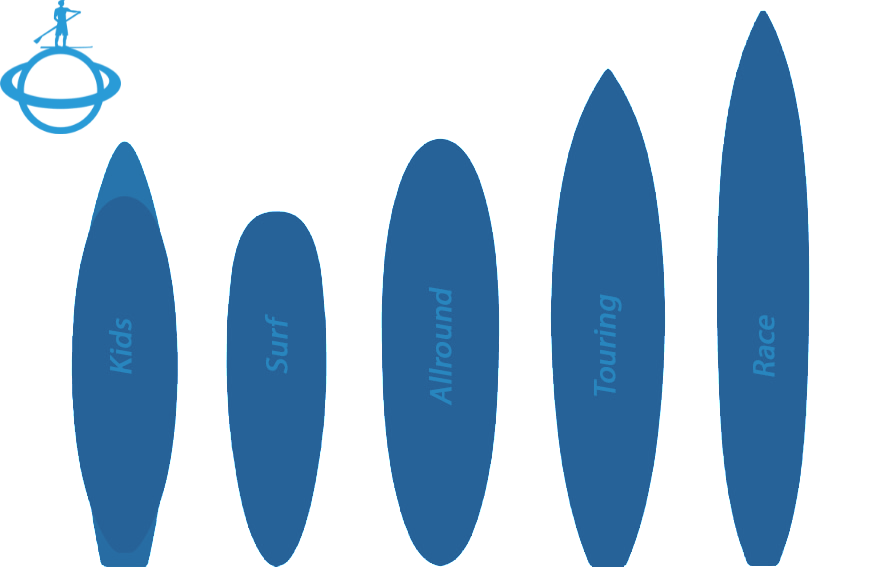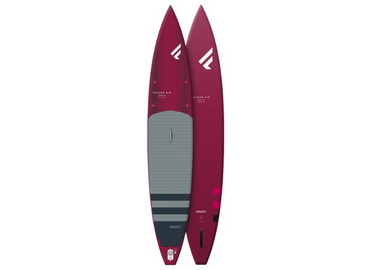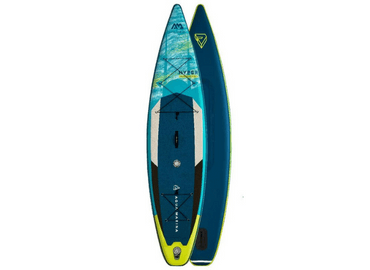Best Lightweight Paddle Board
By: James | Last update: 1 November 2022
Imagine, finally getting that leave approved or it could be a chance occasion that landed you on a long weekend. You pack your coolers with your favorite drinks, put your sunscreen on, get to the garage and remember that you have to lug your 20- to 30-pound paddle board around on a trip. You just don’t want to do anything but have a great time.
In this article, we want you to—besides relaxing on that trip of yours—not carry around a large hunk of board. So, we’re introducing you to the best lightweight paddle board you could get your hands on.
🥇Best inflatable race choice
Fanatic Falcon Air 12’6″
🥇Best hardboard choice
Fanatic Ray Bamboo 12’6″
🥈Best budget choice
Aqua Marina Hyper 12’6″
Why Choose the Best Lightweight Paddle Board?
Besides the freakishly common situation already mentioned above, we’d like to point out more benefits of going with lighter boards vs. heavier ones. Typically, here are some factors why the best lightweight paddle board is more convenient to use:
Most Common Paddle Boards
Now, the most common four types of stand up paddle boards are the following:
- Easier to carry
Generally, as we all know, the lighter the paddle board is, the easier it is to carry. But this comes with some caveats, which will be fleshed out below.
- High maneuverability
Moreover, the lighter the board, the better the underfoot control. Unless we’re talking about boards that are light because their structural integrity has been compromised. This will also be explained in the latter part of the article.
- Easy Transportation
If you live more inland or far away from your favorite body of water, a lighter board will definitely be easier to move around. And if you’re carrying a bunch of things with you, it’ll be easier on your kids, or your back, to have a lighter SUP board.
If ever you are thinking about what kind of paddle board or specifications you want, we’ve narrowed down some information about the different kinds of SUP boards out there:
Touring – This is a great board for you if you move through rivers or areas that need more forward movement. This type typically having a narrower tip called a displacement hull for swifter movement and longer glide times. This is not as speedy as a racing board, but capable of going faster than an all around paddle board.
Race – A race paddle board is what will get you from one remote place to another. Okay, maybe not that far, but this SUP board is built for races and is narrow in shape, has pointier tips, and a length that can bridge Russia and Alaska. (We’re kidding). But it’s mostly and usually the longest out of all the board types.
All Round – If you’re just starting out, this is the board for you. You’re not going to be speeding in paddle board races or traversing whitewater with this type of board unless you’re the more daring type. Usually used on calmer waters, this paddle board is best for doing paddle board yoga, exploring with kids or a pet, or even fishing!
Surf – If you like catching things, you can catch some waves with a paddle board built for surfing. Surf paddle boards are typically shorter than the typical all round SUP boards, but there are surf/all round options out there. Wider around the upper part of the board, it has a pointier end, similar to a touring board. But, there’s a con to every pro; surfing paddle boards are not ideal for calmer waters.

Even the Best Lightweight Paddle Board has Caveats
The best lightweight paddle board is an inflatable SUP board. Again, our judgment may be subjective, but they come from experience. But it isn’t as intuitive as you think. Unlike hard boards where it’s understood that the less matter/board you have, the lighter the SUP board will be—inflatable paddle boards are made through dropstiching: a process that joins two pieces of fabric together. Then, the whole thing is coated in a PVC material 2 – 3 times, not only waterproofing the board but making it capable of sustaining air pressure.
Some think that having less PVC or less dropstiching present will make the board lighter. It’s correct in theory, but you stand to jeopardize the structural integrity and the performance of the board. The lesser the coating, the more bending will occur and thus slow you down when paddling. And when there’s less dropstitching, well, let’s just say you’ll be swimming most of the time.
So when on the lookout for the best lightweight paddle board, balance is the key–not only on the water, but when it comes to your weight & usage vs. the board’s weight and dimensions. Here are three things to keep in mind when looking at a paddle board if lightweight is your priority:
- Your weight
- Board specifications
- Usage needs
- Your Weight
Your weight will play a large role in choosing any board. But, especially when it comes to lightweight boards. Nothing will break, but performance will be below-par if you don’t choose a paddle board suited to your needs. It’s all a matter of volume and buoyancy. A good rule of thumb is to multiply your body weight (in pounds) by 1.1 – 1.4, which will lead you to the volume of the board you need. And to get a board’s volume, just multiply the width, length, and height.
(I myself don’t like math, so there’s a sizing chart further down.)
- Board Specifications
What your board has, is made of, is made with, and is made for, all play into what the best lightweight paddle board is for you. The material used—wood, fiberglass, PVC, and epoxy resins—are usually a mix. But, especially in an inflatable SUP board, the more the PVC layers, the more it can withstand high air pressures. And the higher the air pressure, the more rigid/stiff the board is.
The fins attached play a major role as well. It affects how your board “tracks”, its speed, and how it turns. And going even deeper, the size and specifications of the fins themselves play a role in how they affect performance.
A single, larger fin placed in the back area of the board will help your tracking and speed. More forward placement of the fin will result in better turning and whitewater traversing.
A 2-3 fin setup is typically used for surfing but it can help SUP boards too!
There are also fins for racing.
But, what matters most is the volume and dimensions of a SUP board so here’s a sizing chart:
Sizing Dimensions Guide
| Your Weight | Board Width | Board Thickness | Board Length |
| Below 125 lbs (56kg) | 31-32” | 5” | 9’6″-10’9″ |
| 125-150 lbs (56-68 kg) | 31-32” | 5” | 9’6″-10’9″ |
| 150-175 lbs (68-79 kg) | 31-33” | 5” | 10’0″-12’6″ |
| 175-200 lbs (79 – 90 kg) | 32-34” | 5” | 10’0″-12’6″ |
| 200-225 lbs (90-102 kg) | 32-34” | 5-6” | 10’0″-12’6″ |
| 225+ lbs (102 kgs +) | 32-34” | 6” | 10’0″-12’6″ |
- Usage Needs
As described above, there are multiple types of SUP boards for many different uses. And the above chart is for all-around and touring boards, if you are planning on getting a board for racing or surfing, you might want to consult an in-person expert. So, you can get the best results. And when it comes to usage, you might need a heavier stand up paddle board. So, the extra features (like fins) will help you compensate for the lighter paddle board.
Common Buying Traps: Issues When Buying Online
Today, adding-to-cart has become more and more common than actually going to a physical store. But, there are some problems in buying an item with complex details, e.g. Paddle Boards.
- The board doesn’t come with a warranty
We don’t know about you, but we love a good warranty. There are so many things you’ll find online that are either with mediocre 1-month warranty or none at all. Of course, we’d want you to avoid situations that would damage your board in the first place, but having a backup plan is always practical.
- Poor board sizing
Regardless of quality—as discussed above—sizing and getting the right board for YOU is what matters the most. Refer to the above sizing guide for some help with that.
- Poor pump quality (for inflatable SUPs)
If your online purchase comes with a pump at all, its quality might not be able to withstand maintaining AND raising the PSI of your board. Not only might it take longer to pump, but it might also give you the same workout you would have gotten from paddle boarding.
- Board is designed with limited accessory accessibility or fixed side fins
Yes, you got it right. Although more commonly occurring when buying from sketchy sources, some boards will come with limited accessibility for accessory attachment. And yes, some boards will have some accessories already attached. Whether or not that’s a good thing is up for debate.
Research Factors for the Best Lightweight Paddle Board
Here are some things to keep in mind when doing some of your own research:
| TYPE: Inflatable or Rigid?
What comes to mind when you hear the word inflatable? Is it, pool toys, donuts, or colored kid’s life jackets? Well, an inflatable paddle board not those things at all. There are lightweight rigid options out there but no hardboard can get to the weightlessness of an inflatable. Typically made from fiberglass, layers of epoxy, carbon fiber, double PVC, ethylene vinyl acetate, or polyvinyl chloride, hard or rigid boards are a good option if you’re closer to the waters and don’t have many issues with carrying the board. And, of course, if you’re competing, a rigid board is definitely a better option. There also are other collapsible options for stand up paddle boards. Though it’s pretty new to the SUP board industry, it’s gaining quite the rise. |
| Fin Setups
For optimal customizability and just to save yourself from future headaches, DO NOT get a board that has accessories that cannot be removed. Especially if you’re going to be using one board for multiple environments and occasions, having a board that can’t adapt to your needs is such a pain. (Unless you can afford to buy multiple boards.) |
Conclusion
All of it, whether inflatable, solid, collapsible, or paper, depends on your priorities, your needs, and most especially, your need to get out there and explore the waters of the world. But if you ask us, the best lightweight paddle board would be an inflatable board that has at least 2 PVC coatings and is capable of handling 15 – 20 PSI, basically as hard as possible so that you’ll be able to do most things you’d want to with the board while keeping it’s transportation a breeze.
Learn more about stand-up paddle boarding by reading other articles from our website!



